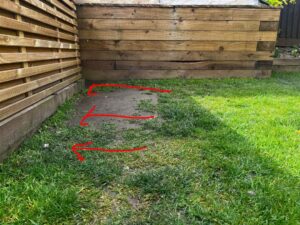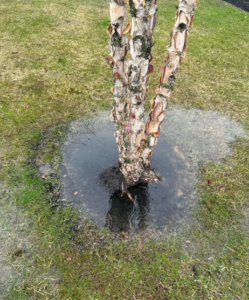VIEWERS QUESTION: I have a tree at the bottom of a slope that tends to flood like this when it rains. This area is actually due to be mulched, but I wanted to know what I could do to prevent this.

THE ANSWER
The tree shown above is a river birch, a riparian species commonly found along watercourses and lowlands, primarily south of the Wisconsin glacial boundary. River birch trees are known for their ability to thrive in wet environments, as they have a high water intake. Despite how the one looks shown in the picture above, the tree’s water intake is not as detrimental as it may seem. In fact, river birch trees can withstand being submerged in water for up to 30 days without experiencing any adverse effects. However, it is likely that the tree would have absorbed all available water by that time.
OPTION #1: Mulch Berm

If you are concerned about the tree being submerged in water for an extended period of time, you can elevate the surrounding area with a mulch berm. It is crucial that you avoid creating a “volcano effect” by piling mulch against the tree’s bark. Based on the appearance of the tree in the picture, it seems to be relatively young. In this case, you can apply a 4-inch layer of mulch around the tree, extending it out to the drip line (the outermost part of the tree’s canopy where water drips onto the ground).
For older trees, it is recommended to follow the 3×3 rule. This involves spreading a 3-inch layer of mulch in a donut shape 3 feet away from the trunk. Continue to regularly inspect the tree and adjust the mulch as needed to ensure its health and growth. Remember, you should be watering the tree as necessary.

OPTION #2: Raised garden bed
Another option you could go with is installing a raised garden bed using bricks. After you have installed the raised bed you can install 3-4″ of mulch. Again, making sure you leave the area around the trunk open (shown in pic above) not piling mulch up against the bark.






